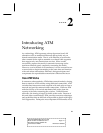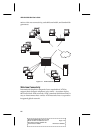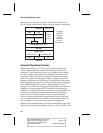
2-4
ANA-5910/5930/5940 User’s Guide
ANA-5910/5930/5940 User’s Guide
Stock Number: 510694-00, Rev. C Page: 2-4
Print Spec Number: 493081-00
Current Date: 5/28/97 ECN Date: 05/29/97
To communicate with another node, an initiating node must initiate
a signaling request to the signaling Virtual Channel Connection (VCC)
residing within the local switch.
Virtual Channel Connections (VCCs)
Virtual Channel Connections (VCCs) are either constructed manually
or constructed by both nodes and all intervening switches.
Manually constructed connections are called Permanent Virtual
Circuits (PVCs) and must be manually deconstructed. With Switched
Virtual Connections (SVCs), one node initiates the VCC setup process
which proceeds switch-by-switch until the desired node is reached.
ATM networks that provide SVCs are considered signaling
environments. Finally VCCs can be point-to-point, allowing one
transmitter and receiver for any cell, or multicast VCCs that allow
one node to transmit a cell that many nodes receive.
An initiating node sends a connection setup request to its switch via
a special signaling VCC. The signaling VCC is an example of a
control VCC - a VCC that remains constantly active. The switch then
cooperates with other nodes to construct a virtual connection that
provides the appropriate Quality of Service (QoS). Link by link, the
procedure reserves the bandwidth required by the connection. If the
connection setup is successful, the nodes communicate using the
VCC which is represented by a Virtual Channel Identifier (VCI) and a
Virtual Path Identifier (VPI). Together, the VCI and VPI identify the
VCC for its duration, and communicating nodes reference the VPI/
VCI pair within each transmitted cell, permitting subsequent cell
switching activity. When the communication process is complete,
one of the communicating nodes initiates the SVC tear-down.
ATM SONET/SDH Support
SONET is an acronym for Synchronous Optical Network - the
contemporary technology many North American telephone
companies use to bundle and transport domestic voice data within
Synchronous Transport Signal (STS) data frames SDH is an acronym
for Synchronous Digital Hierarchy - the contemporary technology
many European telephone companies use to bundle and transport
domestic voice data Synchronous Transport Module (STM) data
frames. Through international standardization efforts, SONET and
SDH are essentially identical except that the smallest STM frame
(STM-1) is three times larger than the smallest STS frame (STS-1).


















